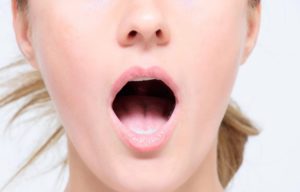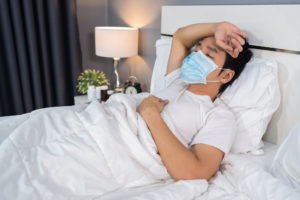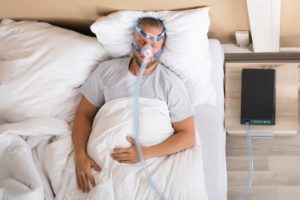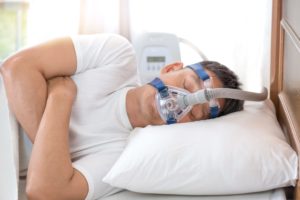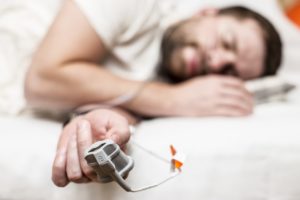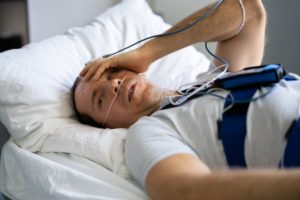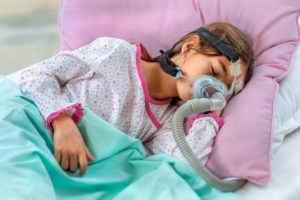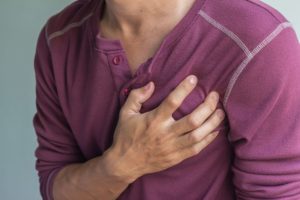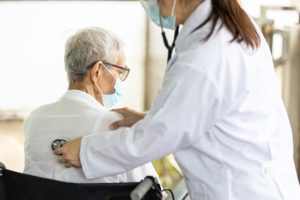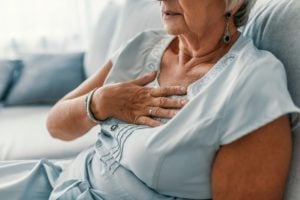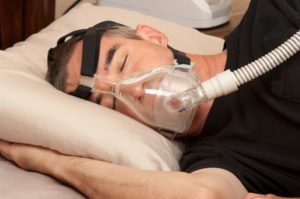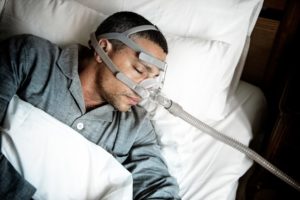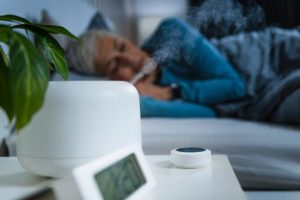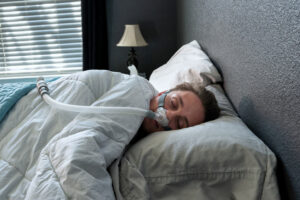When you buy through our links, we may earn a commission. Products or services may be offered by an affiliated entity. Learn more.
Pickwickian Syndrome
Extensive research demonstrates obesity is a risk factor for sleep-related breathing disorders, such as obstructive sleep apnea. Carrying extra body weight may increase the likelihood of sleep-disordered breathing by creating internal pressure, making the airway more prone to collapse and breathing more difficult. Additionally, having obstructive sleep apnea also appears to make obesity more likely, giving these two disorders a complex relationship .
Diagnosing obesity-hypoventilation syndrome (OHS) is important because of health risks associated with the disorder. We discuss OHS symptoms, risk factors, complications, and treatments.
What Is Pickwickian Syndrome?
Pickwickian syndrome , also called obesity-hypoventilation syndrome , is a disorder that can occur in people with obesity and sleep-disordered breathing. People who have the disorder hypoventilate, or breathe in a way that is too slow or too shallow to meet the needs of their body, not only at night, but during the day. As a result, they experience elevated carbon dioxide levels in the bloodstream, called hypercapnia.
In the 1950s, experts came up with the term Pickwickian syndrome after Charles Dickens’ first novel, “The Posthumous Papers of the Pickwick Club”. In this novel, a character named Joe is described as often falling asleep throughout the day and snoring as he sleeps. Currently, the disorder is more commonly referred to as obesity-hypoventilation syndrome (OHS). The American Academy of Sleep Medicine discourages the term Pickwickian syndrome, as it has also been used to describe people with only obesity or obstructive sleep apnea, not OHS.
Understand Your Sleep Apnea Risk
Answer three questions to take charge of troubled sleep.
Symptoms of Pickwickian Syndrome
People with obesity-hypoventilation syndrome (OHS) commonly experience multiple symptoms, including:
- Loud snoring
- Choking or lapses in breathing during sleep
- Excessive daytime sleepiness
- Morning headaches
- Difficulty or labored breathing
- Enlarged neck
- Swelling in the feet, ankles, and legs
Since OHS involves increased carbon dioxide levels in the bloodstream, also called hypercapnia or hypercarbia , people with the disorder may experience additional symptoms related to that element. Increased carbon dioxide in the bloodstream can cause:
- Fatigue
- Confusion
- Flushed skin
- Nausea
- Difficulty breathing during exercise
- Irritability
- Fever
- Wheezing
- Increased sweating
Similar Conditions
OHS is considered a diagnosis of exclusion because so many other disorders manifest similarly and must be ruled out first. The following conditions can produce similar symptoms to those seen in OHS, and doctors might perform tests related to them before giving an OHS diagnosis:
- Central sleep apnea (CSA)
- Chronic obstructive pulmonary disease (COPD) or other lung disease
- Vascular disorder
- Neuromuscular disease, such as amyotrophic lateral sclerosis (ALS)
- Autoimmune disorders Guillain-Barre syndrome or Myasthenia gravis
- Muscular dystrophy
- Poliomyelitis and post-polio syndrome
- Diaphragmatic weakness or phrenic nerve injury
- Myxedema
- Chest wall deformities, or chest wall changes caused by spinal curving
- Bowel distention
- Acute infection
- Erythrocytosis, a red blood cell disorder
- Hypothyroidism
- Central alveolar hypoventilation syndrome
Symptoms seen in OHS can also be caused by medications, such as sedatives or illicit drugs. For this reason, doctors might ask about medications or give a urine drug test as part of their assessment when they observe OHS-like symptoms.
Causes of Pickwickian Syndrome
According to experts, obesity-hypoventilation syndrome (OHS) stems from multiple complex processes in the body rather than a single, clear-cut cause. That said, obesity often plays a role in the disorder , usually by making breathing more difficult. When fat accumulates around a person’s chest and abdomen, the amount of space available for the lungs to expand in is reduced. Being unable to fully breathe in deeply can lead to muscle weakness and reduced lung capacity over time.
People with OHS do not experience the same respiratory drive in response to increased levels of carbon dioxide in the blood that most healthy people experience. Breathing in draws oxygen into the body and blood, and breathing out expels carbon dioxide. Because they have a decreased respiratory drive, people with OHS do not increase the amount they inhale and exhale enough to adequately decrease carbon dioxide levels in their blood. Researchers suspect this decreased respiratory drive could be due to the presence of certain genes, sleep-disordered breathing, or leptin resistance.
Leptin is a hormone created by fat tissue in the body, also called adipose tissue. In addition to helping people feel full and recognize when to stop eating, this hormone can stimulate breathing. When a person has leptin resistance, their leptin levels increase, but their body does not respond accordingly. That means people with OHS experience higher levels of leptin, but leptin resistance may keep their body from signaling when they feel full or need to breathe more.
Risk Factors
Having a higher body mass index (BMI) increases a person’s risk of developing OHS. A person’s BMI is a number calculated using their height and weight . The National Heart, Lung, and Blood Institute defines obesity as having a BMI of 30 or greater, with a BMI over 40 considered extreme obesity . Experts estimate that between 0.15% and 0.3% of adults with a BMI greater than 40 have OHS.
Of those who experience both obesity and sleep-disordered breathing, 10% to 20% have OHS. Obstructive sleep apnea (OSA) is another risk factor for OHS. Of people who have both OSA and obesity, 10% to 15% also have OHS.
OHS appears to be more common in certain groups of people, such as in men. OHS also occurs more frequently among African Americans. In Asian communities, OHS appears to develop at a lower BMI than it does in other groups.

How Is Pickwickian Syndrome Diagnosed?
The American Academy of Sleep Medicine set diagnostic criteria for obesity-hypoventilation syndrome (OHS) in the International Classification of Sleep Disorders, Third Edition (ICSD-3) released in 2014. To be diagnosed with OHS, a person must:
- Experience inadequate breathing, called hypoventilation, while they are awake, resulting in increased carbon dioxide in the blood measuring above 45 mm Hg
- Be categorized as obese, as defined by a body mass index (BMI) above 30
- Not have any other disorders or medications causing their symptoms
Although not diagnostic criteria, people with OHS often find that their hypoventilation and blood carbon dioxide levels worsen during sleep, particularly in the rapid eye movement (REM) stage of sleep. People with OHS often have obstructive sleep apnea (OSA) and should receive a diagnosis of both OHS and OSA if both are present. Those with OHS also tend to experience lower blood oxygen levels, but that is not a diagnostic criteria.
Treatments for Pickwickian Syndrome
Multiple treatments exist for obesity-hypoventilation syndrome (OHS):
- Positive airway pressure therapy: Non-invasive airway pressure therapy, such as continuous positive airway pressure (CPAP) and bi-level positive airway pressure (BiPAP), can help reduce carbon dioxide levels in the blood. Generally, people who have OHS and sleep-related breathing disorders start by using a CPAP machine during sleep. PAP therapy is also sometimes recommended for those who experience higher carbon dioxide levels even without sleep-disordered breathing. Oxygen therapy might be needed for some with OHS.
- Surgery: Weight loss is often recommended to people with OHS. However, when a person has trouble losing weight through lifestyle changes, weight reduction surgeries might be recommended. In extreme cases, a tracheostomy surgery might be used to improve breathing by connecting a tube directly to the airway.
- Medication: Certain medications — medroxyprogesterone, acetazolamide, and theophylline — can potentially lower carbon dioxide levels in blood by stimulating respiration. However, these are not usually prescribed for very long periods of time because of potential side effects.
Prevention
Experts recommend making lifestyle changes, such as exercising regularly and increasing overall physical activity, in order to better manage weight and prevent obesity-hypoventilation syndrome. They also note that many professionals, such as dietitians and therapists, can be enlisted to help with weight management. When a person cannot lose substantial weight through lifestyle changes, bariatric surgery might be considered.
If a person is diagnosed with sleep-disordered breathing, like obstructive sleep apnea, treating that disorder is also an important part of preventing complications.
Outlook for Pickwickian Syndrome
People with obesity-hypoventilation syndrome (OHS) face a greater risk of being hospitalized, going into intensive care, and requiring more long-term care than people who have obesity but not OHS. OHS can progress over time and lead to death if it is not treated early. Studies show that people who have both OHS and another medical condition experience high mortality rates of 23% within 18 months and 46% within 50 months. Treating OHS early on with positive airway therapy can reduce mortality rates by 10%.
Complications
Obesity-hypoventilation syndrome (OHS) is linked with multiple complications. People with OHS, especially when it is not properly treated, may experience heart failure or respiratory failure. The earlier OHS is found and treated, the less likely a person is to experience complications.
Obesity more generally is also linked with multiple complications . Since, by definition, people with OHS have obesity, they are at risk of these complications as well. Complications associated with obesity include high blood pressure, diabetes, hypothyroidism, high cholesterol, liver dysfunction, and osteoarthritis .
When to Talk to Your Doctor
People at risk of obesity-hypoventilation syndrome (OHS) may want to talk to their doctor about prevention of OHS and other health concerns associated with obesity.
Also, it is important to talk with your doctor if you are exhibiting symptoms of sleep-disordered breathing like sleep apnea. Make an appointment with your doctor if you experience these symptoms :
- Extreme tiredness or sleepiness during the day
- Loud snoring
- Gasping or choking during sleep
- Pauses in breathing during sleep
- Suddenly waking from sleep with a snort
- Fatigue
- Irritability
- Morning headaches
- Slow thinking and difficulty concentrating
Discussing these and other concerns with your doctor can help you determine the best course of treatment.

Still have questions? Ask our community!
Join our Sleep Care Community — a trusted hub of sleep health professionals, product specialists, and people just like you. Whether you need expert sleep advice for your insomnia or you’re searching for the perfect mattress, we’ve got you covered. Get personalized guidance from the experts who know sleep best.
References
14 Sources
-
Patel, S. R. (2015). The complex relationship between weight and sleep apnoea. Thorax, 70(3), 205–206.
https://pubmed.ncbi.nlm.nih.gov/25487572/ -
Ghimire, P., & Kaul, P. (2021). Pickwickian syndrome. In StatPearls. StatPearls Publishing., Retrieved March 29, 2022, from
https://www.ncbi.nlm.nih.gov/books/NBK542216/ -
Antoine, M., Katyal, N., & Bollu, P. C. (2021). Obesity-hypoventilation syndrome. In StatPearls. StatPearls Publishing., Retrieved March 29, 2022, from
https://www.ncbi.nlm.nih.gov/books/NBK482300/ -
American Academy of Sleep Medicine. (2014). The International Classification of Sleep Disorders – Third Edition (ICSD-3). Darien, IL: American Academy of Sleep Medicine.
https://learn.aasm.org/ -
Chapman, K., & Dragan, K. E. (2021). Hypercarbia. In StatPearls. StatPearls Publishing., Retrieved March 29, 2022, from
https://pubmed.ncbi.nlm.nih.gov/32644580/ -
Ryan, S., Crinion, S. J., & McNicholas, W. T. (2014). Obesity and sleep-disordered breathing–when two ‘bad guys’ meet. QJM: Monthly Journal of the Association of Physicians, 107(12), 949–954.
https://pubmed.ncbi.nlm.nih.gov/24509235/ -
Brinkman, J. E., Toro, F., & Sharma, S. (2021). Physiology, respiratory drive. In StatPearls. StatPearls Publishing., Retrieved March 29, 2022, from
https://www.ncbi.nlm.nih.gov/books/NBK482414/ -
Dornbush, S., & Aeddula, N. R. (2021). Physiology, Leptin. In StatPearls. StatPearls Publishing., Retrieved March 29, 2022, from
https://www.ncbi.nlm.nih.gov/books/NBK537038/ -
National Heart, Lung, and Blood Institute. (n.d.). Calculate your body mass index., Retrieved February 25, 2022, from
https://www.nhlbi.nih.gov/health/educational/lose_wt/BMI/bmicalc.htm -
National Heart, Lung, and Blood Institute. (n.d.). Classification of overweight and obesity by BMI, waist circumference, and associated disease risks., Retrieved March 4, 2022, from
https://www.nhlbi.nih.gov/health/educational/lose_wt/BMI/bmi_dis.htm -
Littleton, S. W., & Mokhlesi, B. (2009). The Pickwickian syndrome-obesity hypoventilation syndrome. Clinics in Chest Medicine, 30(3), 467–478.
https://pubmed.ncbi.nlm.nih.gov/19700045/ -
Mokhlesi, B., Kryger, M. H., & Grunstein, R. R. (2008). Assessment and management of patients with obesity hypoventilation syndrome. Proceedings of the American Thoracic Society, 5(2), 218–225.
https://pubmed.ncbi.nlm.nih.gov/18250215/ -
Youdim, A. (2021, August). Obesity. Merck Manual Professional Version., Retrieved on February 27, 2022, from
https://www.merckmanuals.com/professional/nutritional-disorders/obesity-and-the-metabolic-syndrome/obesity -
Strohl, K. P. (2020, September). Sleep apnea. Merck Manual Consumer Version., Retrieved on February 27, 2022, from
https://www.merckmanuals.com/home/lung-and-airway-disorders/sleep-apnea/sleep-apnea











